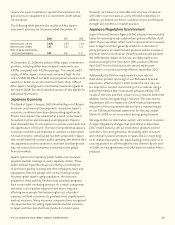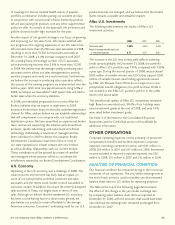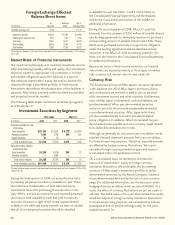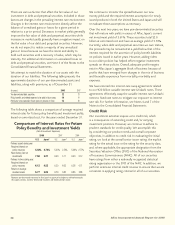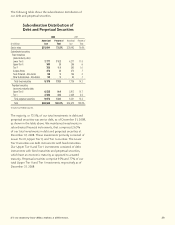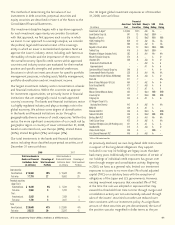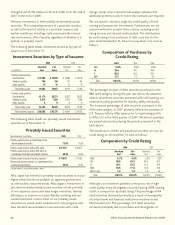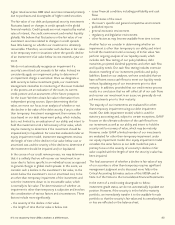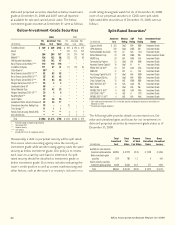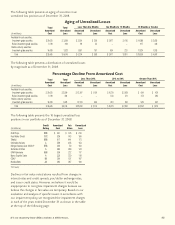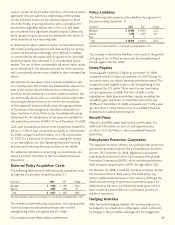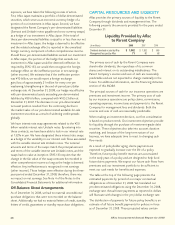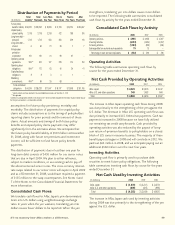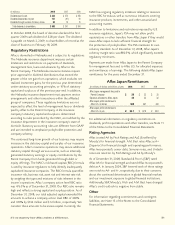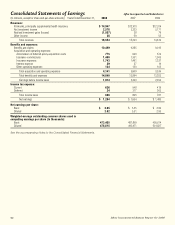Aflac 2008 Annual Report Download - page 47
Download and view the complete annual report
Please find page 47 of the 2008 Aflac annual report below. You can navigate through the pages in the report by either clicking on the pages listed below, or by using the keyword search tool below to find specific information within the annual report.
43
It’s no mystery how Aflac makes a difference.
higher rated securities. BBB rated securities increased primarily
due to purchases and downgrades of higher rated securities.
The fair value of our debt and perpetual security investments
fluctuates based on changes in credit spreads in the global
financial markets. Credit spreads are most impacted by market
rates of interest, the credit environment and market liquidity
globally. We believe that fluctuations in the fair value of our
investment securities related to changes in credit spreads
have little bearing on whether our investment is ultimately
recoverable. Therefore, we consider such declines in fair value
to be temporary even in situations where the specific decline
of an investment’s fair value below its cost exceeds a year or
more.
We do not automatically recognize an impairment if a
security’s amortized cost exceeds its fair value. Instead, we
consistently apply our impairment policy to determine if
an impairment charge is warranted. Once we designate a
debt security as below investment grade, our investment
management intensifies its monitoring of the issuer. Included
in this process are an evaluation of the issuer, its current
credit posture and an assessment of the future prospects
for the issuer. We then obtain fair value information from
independent pricing sources. Upon determining the fair
value, we move our focus to an analysis of whether or not
the decline in fair value of the debt security, if any, is other
than temporary. Investment management then reviews the
issue based on our debt impairment policy, which includes,
but is not limited to, an evaluation of our ability and intent to
hold the investment until a full recovery of fair value, which
may be maturity, to determine if the investment should be
impaired and/or liquidated. For securities evaluated under an
equity impairment model, investment management reviews
the length of time of the decline in fair value below cost or
amortized cost and the severity of the decline to determine if
the investment should be impaired and/or liquidated.
In the course of our credit review process, we may determine
that it is unlikely that we will recover our investment in an
issuer due to factors specific to an individual issuer, as opposed
to general changes in global credit spreads. In this event, we
consider such a decline in the investment’s fair value, to the
extent below the investment’s cost or amortized cost, to be
an other-than-temporary impairment of the investment and
write the investment down to its recoverable value, which
is normally its fair value. The determination of whether an
impairment is other than temporary is subjective and involves
the consideration of various factors and circumstances. These
factors include more significantly:
• the severity of the decline in fair value
• the length of time the fair value is below cost
• issuer financial condition, including profitability and cash
flows
• credit status of the issuer
• the issuer’s specific and general competitive environment
• published reports
• general economic environment
• regulatory and legislative environment
• other factors as may become available from time to time
Another factor we consider in determining whether an
impairment is other than temporary is our ability and intent
to hold the investment until a recovery of its fair value. We
perform ongoing analyses of our liquidity needs, which
includes cash flow testing of our policy liabilities, debt
maturities, projected dividend payments and other cash flow
and liquidity needs. Our cash flow testing includes extensive
duration matching of our investment portfolio and policy
liabilities. Based on our analyses, we have concluded that we
have sufficient excess cash flows to meet our liquidity needs
without liquidating any of our investments prior to their
maturity. In addition, provided that our credit review process
results in a conclusion that we will collect all of our cash flows
and recover our investment in an issuer, we generally do not
sell investments prior to their maturity.
The majority of our investments are evaluated for other-
than-temporary impairment using our debt impairment
model. Our debt impairment model, which is used for
statutory accounting and, subject to certain exceptions, GAAP
focuses on the ultimate collection of the cash flows from
our investment as well as our ability and intent to hold the
security until a recovery of value, which may be maturity.
However, under GAAP a limited number of our investments
are evaluated for other-than-temporary impairment under
our equity impairment model. Our equity impairment model
considers the same factors as our debt model but puts a
primary focus on the severity of a security’s decline in fair
value coupled with the length of time the security’s value has
been impaired.
The final assessment of whether a decline in fair value of any
of our securities is other than temporary requires significant
management judgment and is discussed more fully in the
Critical Accounting Estimates section of this MD&A and in
Note 3 of the Notes to the Consolidated Financial Statements.
In the event of a credit rating downgrade to below-
investment-grade status, we do not automatically liquidate our
position. However, if the security is in the held-to-maturity
portfolio, we immediately transfer it to the available-for-sale
portfolio so that the security’s fair value and its unrealized gain
or loss are reflected on the balance sheet.


